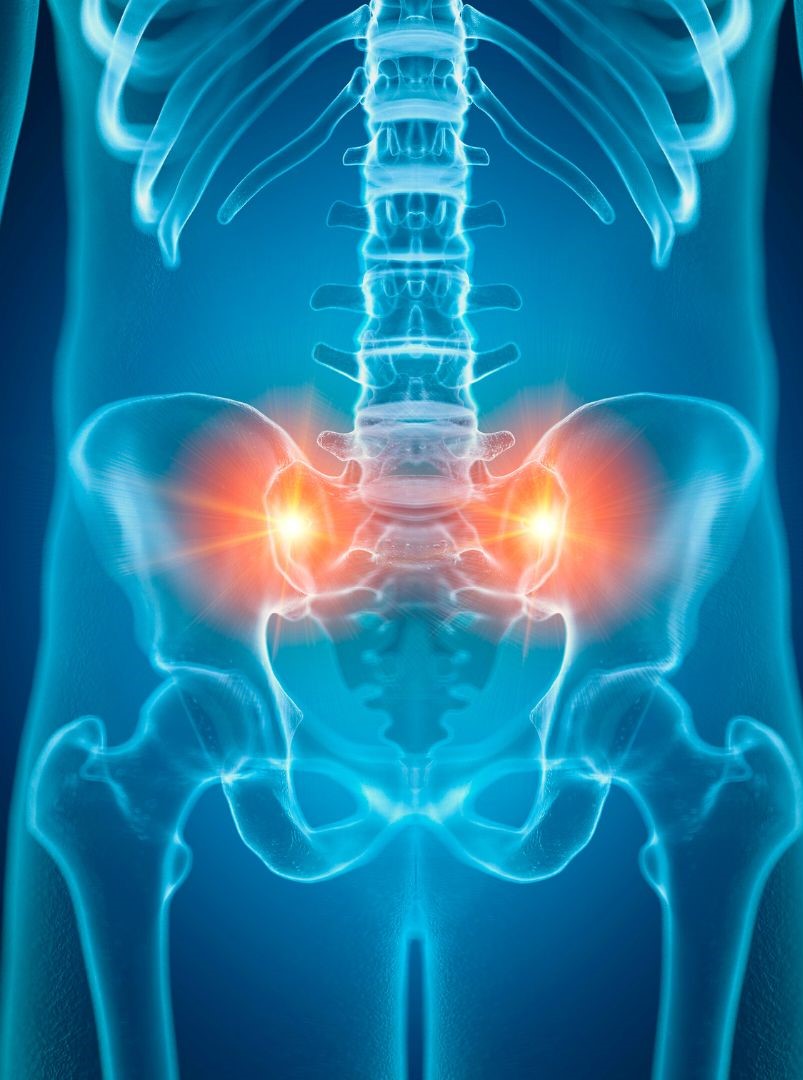
Sacroiliac Joint Dysfunction
Ah, the sacroiliac joint, the hippest joint in town! But sometimes, this joint can be a real troublemaker, causing SIJ dysfunction and making life a pain in the backside, quite literally. But, if your sacroiliac joint is giving you trouble don’t worry – the chiropractors at Bayside Chiropractic have got your back.
The sacroiliac joint performs a delicate balancing act between the sacrum (the triangular bone at the base of the spine) and the ilium (part of the pelvis). It’s a synovial joint with limited mobility, designed to bear weight and transmit forces between the upper body and lower extremities. It is the ONLY joint connecting the spine to our lower body, so it’s got a lot of work to do.
But sometimes life happens, and the joint gets a little irritated. Injury, trauma, or even pregnancy-related hormonal changes can lead to issues arising in these joints. When that happens, the joint can become mispositioned with abnormal motion occurring. And this can lead to pain – pain in the lower back, the buttocks, and the hips, pain that worsens with sitting, standing, walking or changing position. It can lead to numbness and tingling down the legs and difficulty walking. For some it’s a dull ache, but for others it a stabbing pain (Ouch).
What’s Causing It
There are a few possible causes.
- Increased laxity of the sacroiliac ligaments: This can occur due to hormones during pregnancy. The ovaries pump out relaxin specifically to relax the pelvis to make it easier for the baby to pass through the birth canal. So, it’s doing its job when it makes ligaments lax, but if they’re too lax they can’t support the sacroiliac joint as they should.
- Inflammation of the sacroiliac joint: Injury, infection, or overuse can cause this.
Physical misalignment is one of the most common culprits. If muscles aren’t quite working as they should they can pull the bones that form the joint, leading to a slight misalignment of the joint itself. Imagine the hip flexors, gluteal muscles, and core stabilisers all having a dance-off, but they’re not quite in time with each other… chaos can ensue. Poor posture also puts the joint under stress – if you’re rocking an extreme forwards or backwards pelvic tilt, you’re basically giving the SIJ a rollercoaster ride it didn’t sign up for, one that over time can lead to dysfunction.
Repetitive activities or occupations that involve prolonged sitting, standing, or lifting can also strain the SIJ, causing inflammation and pain. How? Well, holding any position for too long creates muscle imbalances, which we already know are problematic. It can also lead to uneven weight distribution. When you sit, for example, your weight is distributed differently than when you stand. This can put more stress on the SIJ and lead to pain.
What To Do About It?
Your first step should be to call us on (02) 9523 9940. The chiropractors at Bayside Chiropractic can use various techniques to relieve your pain and discomfort. Chiropractors are known for their expertise in spinal adjustments. They may use manual manipulation techniques to gently realign the spine and pelvis, including the sacroiliac joint. By applying controlled force, they aim to restore proper joint motion and alleviate SIJ dysfunction. We’ll also use soft tissue techniques such as massage, myofascial release, or trigger point therapy to address muscle imbalances and tension around the SIJ.
These techniques can help relax tight muscles, improve flexibility, and reduce stress on the joint. We can also recommend specific exercises to strengthen and stretch the muscles around the SIJ to improve joint stability and movement. We’ll also prescribe exercises to help promote proper posture. If you can get the glutes, core, hip flexors and hamstrings working well together again it will stave off future SIJ dysfunction – so exercise is key!
Lastly, we’ll dig into some practical solutions. While everyone is different, we find the below lifestyle tips help most of our patients suffering from SIJ dysfunction:
- Use a supportive chair: Make sure your chair has good lumbar support. You may also want to use a pillow or rolled-up towel to support your lower back.
- Avoid sitting for long periods of time: Get up and move around every 20-30 minutes.
- Choose a supportive mattress: Make sure your mattress provides good support for your lower back.
- Wear supportive shoes: Shoes that provide good arch support can help to reduce stress on your sacroiliac joints.
So, while it’s painful, there is light at the end of the tunnel. Give us a call on (02) 9523 9940, the chiropractors at Bayside Chiropractic are here to help you through the pain and to better alignment and movement. You can find us on Facebook for more helpful information.
Read more of our Blogs here.

